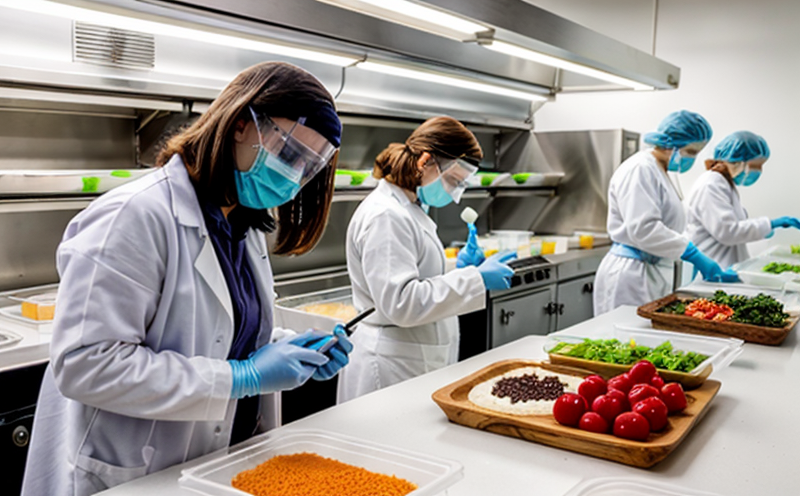EN 12322 Campylobacter Detection Testing in Poultry Meat
The CEN standard EN 12322:2005 specifies a method for the detection of Campylobacter spp. in poultry meat products. This test is crucial due to the significant health risks associated with Campylobacter infections, which are primarily attributed to contaminated food, especially poultry. Compliance with this standard ensures that the poultry meat produced meets stringent international quality and safety standards.
The presence of Campylobacter has been linked to a wide range of illnesses, including gastroenteritis in humans. The World Health Organization (WHO) estimates that Campylobacter is responsible for over 200 million cases worldwide each year. In the context of food microbiology testing, this standard plays a pivotal role by providing a standardized approach to ensure the safety and quality of poultry meat products.
The EN 12322 method involves several key steps: sampling, sample preparation, inoculation, incubation, isolation, identification, and confirmation. The first step is the collection of samples from various parts of the carcass or processed products. Samples are then prepared by homogenizing them in a buffered peptone water solution. After inoculating the prepared samples into selective media, they are incubated under specific conditions to facilitate the growth of Campylobacter.
Once colonies appear on the selective medium, further steps include biochemical identification and confirmation using tests like PCR or serological methods. This rigorous process ensures accurate detection and identification of Campylobacter species in poultry meat. The standard also specifies acceptance criteria based on colony counts and other indicators to ensure product safety.
Adhering to this method is not only a regulatory requirement but also a commitment to public health and consumer protection. By ensuring that Campylobacter levels are below the specified limits, processors can contribute significantly to reducing foodborne illness risks. This standard is particularly important for large-scale poultry producers who export their products internationally.
Understanding the implications of this test is essential for quality managers, compliance officers, R&D engineers, and procurement teams working in the meat processing industry. Regular testing helps maintain a high level of product safety and customer satisfaction, thereby enhancing brand reputation and market competitiveness.
Why It Matters
The detection of Campylobacter in poultry meat is vital for several reasons:
- Public Health Protection: Campylobacteriosis can lead to severe gastrointestinal symptoms, making its presence a significant public health concern.
- Regulatory Compliance: Many countries enforce strict regulations regarding the presence of pathogens like Campylobacter in food products. Failure to comply with these standards can result in product recalls and reputational damage.
- Consumer Trust: Consumers expect safe, high-quality meat products. Detecting and eliminating contamination builds trust and loyalty among customers.
By implementing the EN 12322 standard, food processors demonstrate their commitment to maintaining the highest standards of hygiene and safety in poultry production. This approach not only protects consumers but also ensures that businesses remain competitive and compliant with international trade agreements.
Scope and Methodology
The scope of EN 12322 primarily focuses on the detection of Campylobacter spp. in raw or processed poultry meat products. This includes both whole carcasses and pre-packaged cuts such as breasts, legs, wings, and ground meats.
The methodology outlined in the standard involves several critical steps:
- Sampling: Samples are taken from different parts of the carcass or processed products to ensure a representative sample set.
- Preparation: The samples are homogenized using buffered peptone water, which provides an optimal environment for Campylobacter growth.
- Inoculation: Prepared samples are inoculated into selective media designed to promote the growth of Campylobacter.
- Incubation: The inoculated plates are incubated under conditions that optimize the growth of these bacteria, typically at 42°C for 48 hours.
- Isolation and Identification: Once colonies appear, they are further identified using biochemical tests or molecular techniques like PCR.
- Confirmation: Final confirmation is done through additional testing methods such as serological assays or genotyping to ensure accurate identification.
The acceptance criteria specify that the number of Campylobacter colonies must be below a predetermined limit, indicating compliance with safety standards. This rigorous process ensures that only safe products reach consumers.
Environmental and Sustainability Contributions
The detection of Campylobacter in poultry meat has indirect environmental benefits by promoting safer food practices:
- Reduction in Waste: By detecting and eliminating contamination early, processors can reduce the amount of spoiled or unsafe product that ends up as waste.
- Optimized Resource Use: Ensuring safe meat production minimizes the need for additional processing steps, thus optimizing resource use.
- Enhanced Consumer Confidence: Safe products lead to increased sales and reduced returns, which in turn supports a more sustainable food supply chain.
Furthermore, adherence to international standards like EN 12322 contributes to global efforts towards improving public health and reducing the spread of zoonotic diseases. This not only benefits individual countries but also promotes international trade by ensuring consistent quality across borders.





